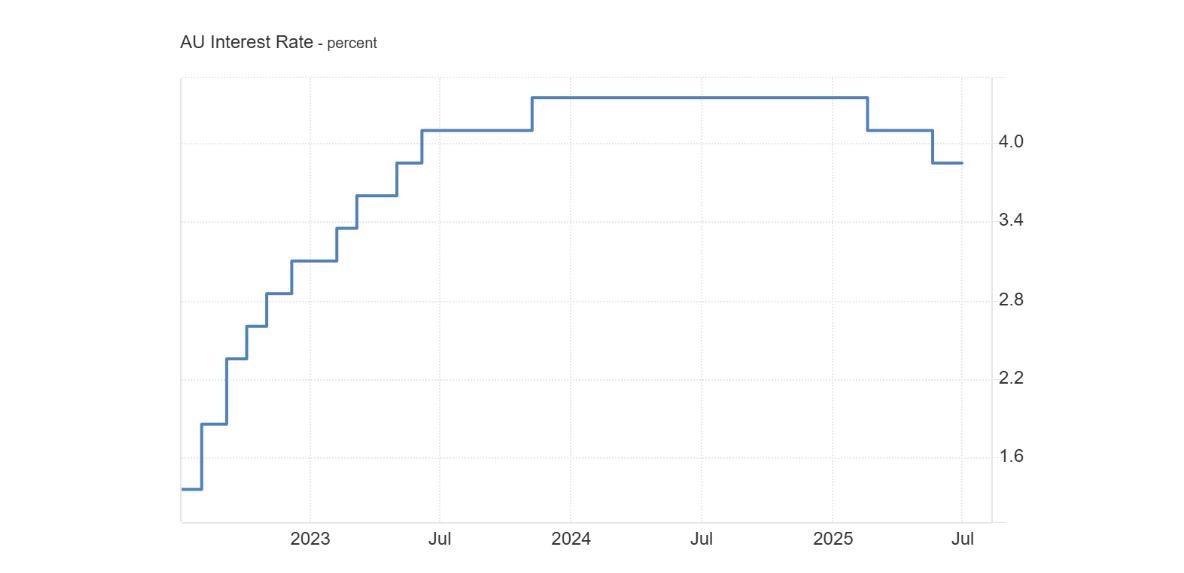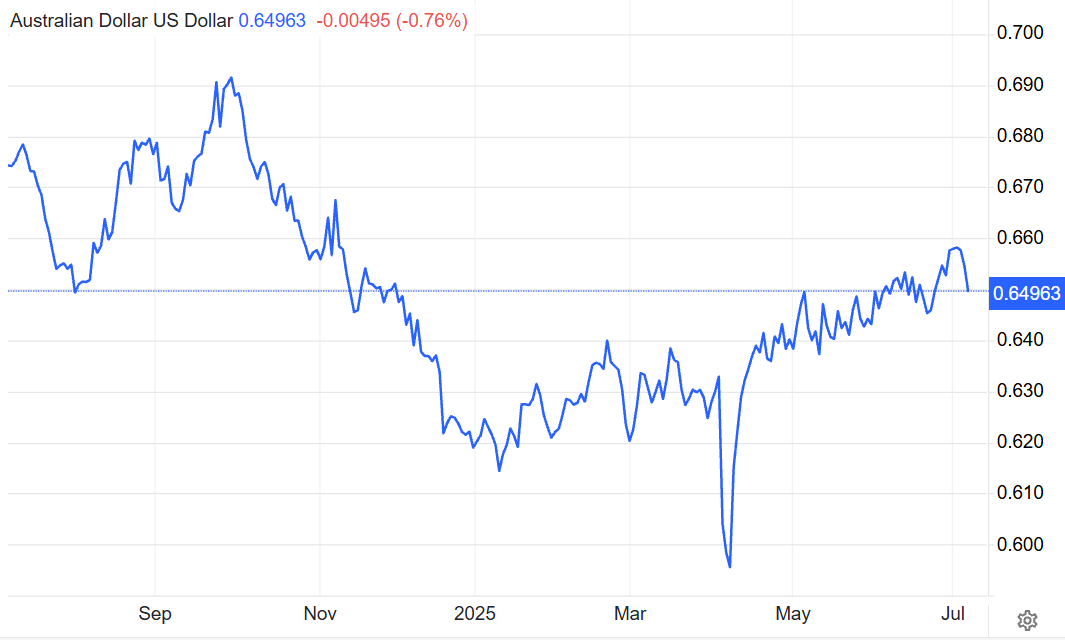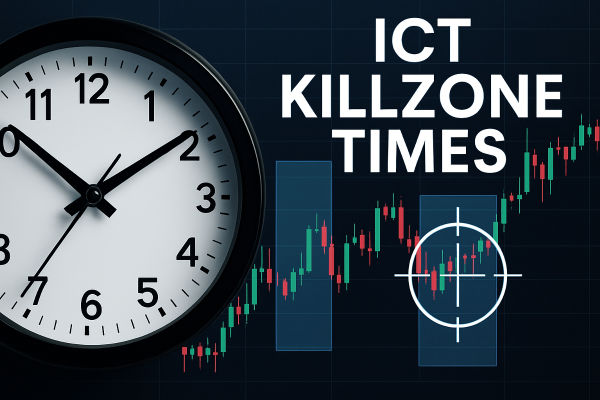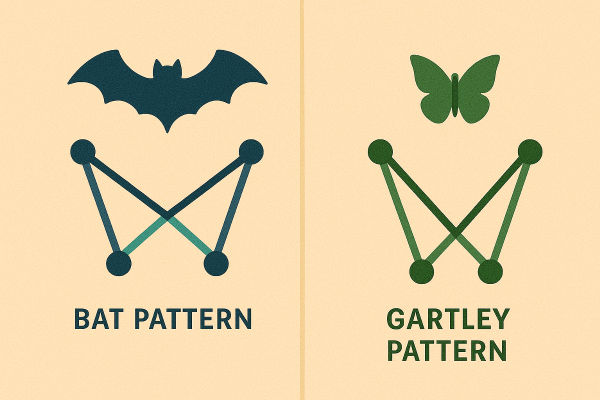The AUD trend has captured trader attention once again as markets brace for a potential consecutive interest rate cut by the Reserve Bank of Australia (RBA) and growing geopolitical uncertainty surrounding global trade policies. While the Australian dollar (AUD) has benefited from recent US dollar softness, its next moves will likely depend on the RBA's policy signals and developments in international trade tensions.
With inflationary pressures easing and domestic spending remaining soft, the RBA is widely expected to lower the cash rate by 25 basis points to 3.6% in its July 8 decision. If realised, this would mark a second straight month of rate cuts — a clear pivot toward policy easing. Despite this, the AUD trend has remained relatively steady, signalling that markets may have already priced in the decision. Still, traders will closely watch RBA Governor Michele Bullock's commentary for clues on the pace and extent of future monetary easing.
RBA Poised to Cut Rates Again Amid Domestic Softness
 Australia's economic landscape has shifted noticeably since the RBA last held rates steady. Inflation has now moved closer to the RBA's 2–3% target range, and household consumption has shown signs of strain. Consumer confidence surveys continue to reflect a downbeat mood, with pessimism driven by cost-of-living pressures and limited wage growth.
Australia's economic landscape has shifted noticeably since the RBA last held rates steady. Inflation has now moved closer to the RBA's 2–3% target range, and household consumption has shown signs of strain. Consumer confidence surveys continue to reflect a downbeat mood, with pessimism driven by cost-of-living pressures and limited wage growth.
These factors have given the RBA room to act more decisively. Most economists believe a second rate cut is likely in July, bringing the benchmark rate to 3.6%. Market pricing suggests that the cash rate could fall further to 3.1% by year-end, assuming that inflation remains under control and economic activity softens further.
However, some institutions — including Bank of America — argue that the RBA may opt for a wait-and-see approach. Their view is supported by the fact that core inflation remains at the upper end of the target range, and the RBA has not demonstrated urgency in loosening policy beyond what is necessary.
Trader Focus Shifts to RBA Forward Guidance

With the July rate cut largely priced in, the spotlight now turns to forward guidance. Governor Michele Bullock's remarks at the post-decision press conference will likely influence near-term market direction, particularly if she strikes a more dovish tone.
Any indication that the RBA is prepared to continue cutting in coming months could weigh on the AUD, especially if paired with signals of weakness in household spending or global demand. Conversely, a more cautious message that emphasises data dependency could help stabilise the currency and keep the AUD trend from slipping further.
External Pressures: US Trade Policy and Global Risk Sentiment

The RBA's policy decision also coincides with the looming deadline of the US reciprocal tariff agreement — a development that could add fresh volatility to global markets. Rising trade tensions have the potential to undermine commodity-linked currencies like the AUD, particularly if Australian exports face indirect consequences from global supply chain disruptions.
Analysts point out that the mid-term AUD trend could be heavily influenced by the trajectory of US trade policy. If tariffs are imposed or if global risk sentiment deteriorates, the Australian dollar may face headwinds. On the other hand, should trade tensions ease or diplomatic progress be made, the AUD could recover ground and continue its upward move against the US dollar.
Markets Expect Limited Volatility on Well-Telegraphed Cut
Despite the potential for longer-term volatility, most economists believe the AUD's near-term reaction to the July rate cut will be muted. With the decision largely expected and already priced in, the immediate market impact may be modest — unless the RBA surprises with a more aggressive tone or signals an accelerated easing path.
So far in 2025. the AUD/USD pair has gained approximately 5%, buoyed primarily by weakness in the US dollar. As such, much of the recent strength in the AUD trend may reflect external factors rather than domestic resilience.
Conclusion: Cautious Optimism or Currency Headwinds Ahead?
The AUD trend in the second half of 2025 will likely hinge on the delicate interplay between domestic monetary easing and international trade developments. While a well-signalled rate cut may have minimal short-term impact, the tone of the RBA and evolving geopolitical risks will shape trader sentiment going forward.
Should trade tensions intensify or if the RBA signals further accommodation, the AUD could face renewed pressure. However, easing inflation and measured rate cuts could also support a more orderly adjustment, helping the Australian dollar find stability in a volatile global landscape.
Traders would do well to watch not just the central bank's immediate actions, but also the broader narrative shaping Australia's position in a changing economic world.
Disclaimer: This material is for general information purposes only and is not intended as (and should not be considered to be) financial, investment or other advice on which reliance should be placed. No opinion given in the material constitutes a recommendation by EBC or the author that any particular investment, security, transaction or investment strategy is suitable for any specific person.



 Australia's economic landscape has shifted noticeably since the RBA last held rates steady. Inflation has now moved closer to the RBA's 2–3% target range, and household consumption has shown signs of strain. Consumer confidence surveys continue to reflect a downbeat mood, with pessimism driven by cost-of-living pressures and limited wage growth.
Australia's economic landscape has shifted noticeably since the RBA last held rates steady. Inflation has now moved closer to the RBA's 2–3% target range, and household consumption has shown signs of strain. Consumer confidence surveys continue to reflect a downbeat mood, with pessimism driven by cost-of-living pressures and limited wage growth.



















